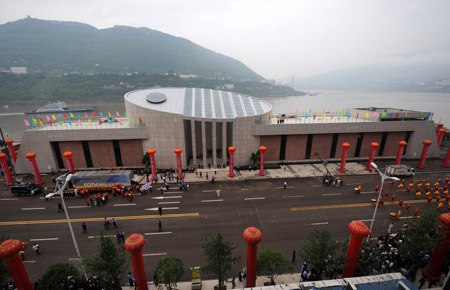|

|
|
Photo taken on May 18, 2009 shows Baiheliang Underwater Museum in southwest China's Chongqing Municipality. Baiheliang Underwater Museum was unveiled on May 18, 2009 after years of construction. Baiheliang, also called White Crane Ridge, is a natural stone ridge located in the Yangtze River in the north of Fuling. The ridge, 1,600 meters long and 10 to 15 meters wide, has 165 pieces of inscriptions left by poets and writers dating back to Tang Dynasty. These inscriptions consist of more than 30,000 characters, reflect the situation of water level in 72 years out of the past 1,200 years. After these precious cultural heritages were submerged because of the construction of Three Gorges Dam, the country invested a huge amount of money into the construction of the museum to protect them. [Photo: Xinhua]
|
A ceremony was held in Chongqing on Monday to mark the completion of China's first underwater museum, built in the Three Gorges Dam area.
The Baiheliang Museum, which cost 189 million yuan (27.6 million U.S. dollars), was built about 40 meters below surface in the upper reaches of the Yangtze River off the coast of Fuling City, Chongqing Municipality. The structure protects a reef created about 1,200 years ago to measure the changes in water levels.
The complex consists of the museum, a connecting passageway, an underwater anti-collision pier and an exhibition room on land.
Construction of the main part of the museum was completed in 2006, before the dam raised the water level in 2008.
Baiheliang, literally "White Crane Ridge", is a 1,600-meter-long and 25 meter-wide smooth stone ridge engraved with inscriptions about China's longest river, dating from 763 in the Tang Dynasty to the early 20th century.
On the huge rock are 20 fish sculptures that serve as water-level markers and about 30,000 characters of Chinese poems from different dynasties.
It is claimed to be the world's oldest hydrographic survey device and is one of the four state-level national treasures in the Three Gorges area.
The museum is expected to open to tourists Wednesday. Visitors may observe the reef through a video camera on the land, windows on the underwater corridor, or they may simply dive into the water.